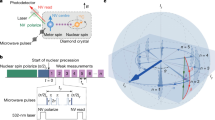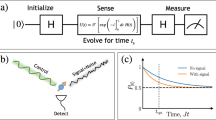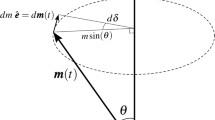Abstract
IN the detection of nuclear induction signals, it is usual to modulate the main polarizing magnetic field in such a way that its intensity sweeps cyclically over a small region embracing the resonance value1. If the amplified signal is fed to a cathode-ray oscilloscope in which the X-sweep follows the instantaneous field modulation, it gives rise to a ‘blip’ at a corresponding part of the trace.
This is a preview of subscription content, access via your institution
Access options
Subscribe to this journal
Receive 51 print issues and online access
$199.00 per year
only $3.90 per issue
Buy this article
- Purchase on Springer Link
- Instant access to full article PDF
Prices may be subject to local taxes which are calculated during checkout
Similar content being viewed by others
References
Bloch, F., Phys. Rev., 70, 460 (1946).
Bloembergen, N., Purcell, E. M., and Pound, R. V., Phys. Rev., 73, 679 (1948).
Bloch, F., and Garber, D. H., Phys. Rev., 76, 585 (1949).
Author information
Authors and Affiliations
Rights and permissions
About this article
Cite this article
ROSS, I., JOHNSON, F. A Sensitive Method of Recording Nuclear Induction Signals. Nature 167, 286–287 (1951). https://doi.org/10.1038/167286b0
Issue Date:
DOI: https://doi.org/10.1038/167286b0
Comments
By submitting a comment you agree to abide by our Terms and Community Guidelines. If you find something abusive or that does not comply with our terms or guidelines please flag it as inappropriate.



